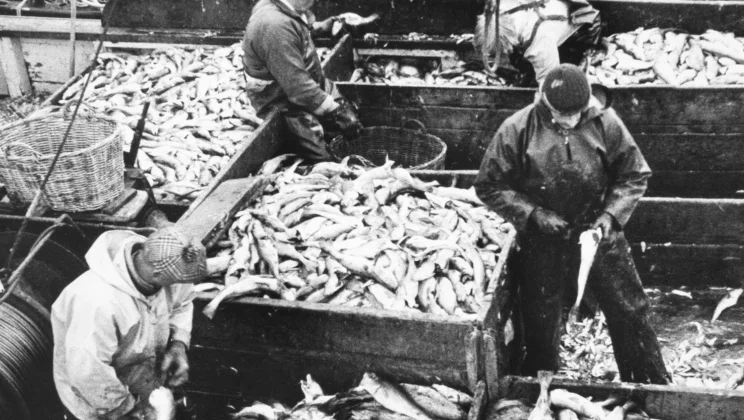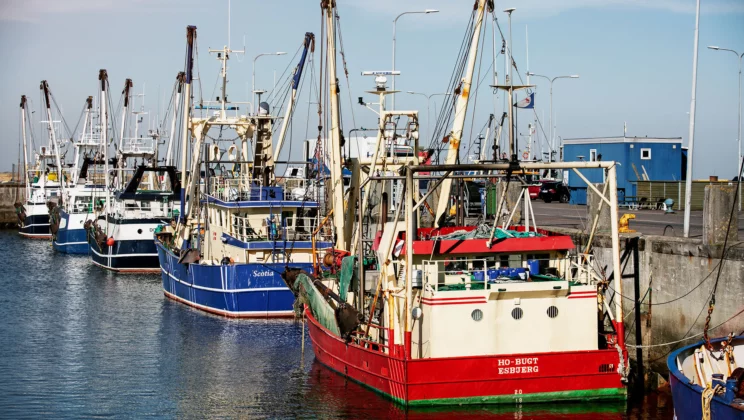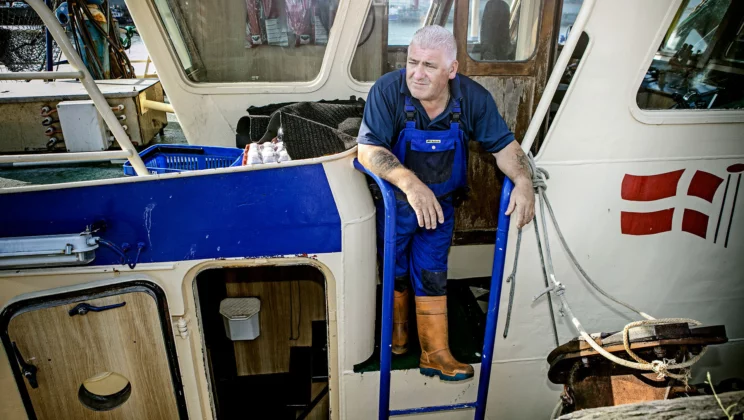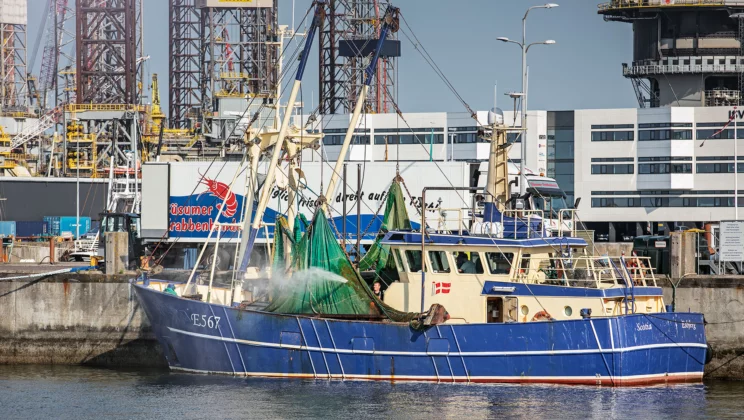A new exhibition at the Fisheries and Maritime Museum celebrates Esbjerg's past as a fishing village. But although its era as Denmark's largest fishing port is over, and industrial fishing is suspended, shellfish are still being landed in Esbjerg. In fact, the amount has doubled over the past five years, and a new certification for the local shrimp boats bodes well for the future.
Tony Divers fishes for shrimp in Esbjerg. Has he been doing so for 13 years and has been a fisherman for close to four decades. His cutter E 567 SCOTIA is berthed in the first basin of the harbour along with nine other shrimp boats. Tony lands about 100 tons of shrimps annually, he says.
"Business is good these years. The price of shrimp is rising and fuel is cheap," says Tony Divers.
The fishing industry at the museum
Otherwise, Esbjerg's days as Denmark's largest fishing port are over. The exhibition "Denmark's wildest fishing adventure" opened on 24 April – the port's birthday – and recounts the heyday of fishing in Esbjerg, told by the fishermen themselves.
Museum Director David Dupont-Mouritzen explains that Esbjerg's past as a fishing village certainly deserves a mention at the museum:
"Fishing is in Esbjerg's DNA," he says. Even though fishing was not in the cards when the Danish government decided to build a port in 1868. Back then the port faced west and was used to export cattle.
But then the fishermen arrived.
By the beginning of the 1900s, Esbjerg had become one of Denmark's largest fishing ports. Its success culminated in 1970, when there were 370 industrial trawlers and 230 Danish seine cutters at the Port of Esbjerg. The 600 cutters employed more than 2,000 fishermen.
After that, the level began to decline, and in 2002 the last fish auction was held at the port.
"Esbjerg would have been a completely different city if not for the fisheries sector. There is a determination and a devil-may-care attitude in Esbjerg that is different than elsewhere. This spirit comes from the fishing adventure," says David Dupont-Mouritzen and elaborates:
"Esbjerg was the Nordic answer to Chicago in the 1900s, and it attracted daredevils and brave men wishing to try their luck at sea."
It is their stories that will be told by the new exhibition, which, incidentally, also marks the Fisheries and Maritime Museum's 50th anniversary. The museum was a gift to the city and port in connection with 100th anniversary in 1968.

By the 1970's, the fishing industry at the Port of Esbjerg peaked with more than 600 cutters. In this photo, cutters have just landed at at the Port with edible fish ready to be gutted.
Shrimp fishing still going strong
Though industrial fishing has left Esbjerg, shrimp fishing remains.
Of the 28 cutters that have licences in Denmark, 20 of them are registered in Esbjerg and Hvide Sande, according to Jesper Juul Larsen, who is the President of the Southwest Jutland Fisheries Association. The remaining 8 boats catch fish from Rømø and Thyborøn.
Jesper himself has fished all his life. At least since he was apprenticed to a local fisherman at the Port of Esbjerg at the age of 14. His time at sea was interrupted only by some periods at school, and in 2005 he stepped ashore and devoted himself to being president of the fisheries association, which today has 240 members engaged in fishing activities in Esbjerg and Hvide Sande.
Shrimp fishing takes place mainly from Thorsminde and down to the German border. It varies whether the boats sail north or south and so Esbjerg is well placed because from here they can sail in either direction. "The location is good and so are the logistics in Esbjerg when it comes to transporting the shellfish," he says.
From Esbjerg, the shrimp are driven to Germany to be sorted. From here they go to the Netherlands, and then on to Morocco, where they are peeled. Then they return to the Netherlands, before ending up in refrigerated counters in German and French supermarkets.
The 10 shrimp vessels in Esbjerg have a turnover of a good DKK 50 million a year and typically employ 3-4 men each, according to Jesper Juul Larsen.

There are ten shrimp vessels in Esbjerg. They have a turnover of DKK 50 million annually.
New certificate bodes well
In 2017, 1,439 tonnes of shellfish were landed at the Port of Esbjerg. That is more than a doubling since 2013, when 682 tonnes were landed. Crangon shrimp are the biggest part of the explanation. Prices have risen in recent years, both Tony Divers and Jesper Juul Larsen explain.
"Right now, the future looks promising for shrimp fishermen," says Jesper Juul Larsen. When he used to go fishing for shrimp, he was rarely paid more than DKK 35 per kilo. Today, the prices are at DKK 70-80.
The increased demand comes partly in the wake of a new sustainability certification that the prawn fishermen from Esbjerg achieved on 1 January this year. The work has been a long time coming, according to Jesper Juul Larsen. But now, all the vessels on the west coast, in the Netherlands and in Germany have the so-called MSC certification (Marine Stewardship Council, ed.). The certification has given the Crangon shrimp fishing the official stamp of approval as sustainable.
Tony Divers is pleased about the certificate.
"The certificate means we get more money for the shrimp. At the same time, we know that the market is focusing more and more on sustainability, due to consumer demand. New markets have therefore opened up now that our fishing is certified as sustainable," he says.

Tony Divers has fished shrimp for the past 13 years. He is optimistic about the future of shrimp fishing in Esbjerg.
From fish to windmills
Comet Trawl, the last remaining net maker in Esbjerg, is based not far from the first basin in the port. Here, John Boberg Brink and his staff serve shrimp boats, for example, by repairing their nets and maintaining their ropes and fishing tackle.
When the fishing industry was at its peak, service and repairs constituted up to 80% of Comet Trawl's business. Today, John Boberg Brink estimates that servicing the vessels comprises no more than 10% of its business.
On the other hand, Comet Trawl now uses the skills the fishing industry has provided for work in the offshore industry.
"We have Siemens, Esvagt and Viking as customers today, and make various materials, for example, for anchoring with bouys," says John Boberg Brink.
In this way, Comet Trawl is a good example of how fishing has sown the seeds for the offshore and energy success story that is taking place in Esbjerg these years, according to David Dupont-Mouritzen, Director of the Maritime and Fisheries Museum.
"A great many of the competencies established by fishing are now playing a new role in the offshore industry," he says, pointing to ESVAGT from Esbjerg as another example of how skills and determination from the fishing industry have been converted.
"The first ESVAGT ships were old fishing cutters crewed by fishermen. Many fishermen also found new work on the platforms in the North Sea."
When the industrial fishing moved from Esbjerg, it did not mean that the fishing industry disappeared altogether. Over the years fish and shellfish have been collected from the world market and processed at the port of Esbjerg. To this day, this means that there are still jobs at the Port of Esbjerg relating to the fishing industry. Some of the workplaces can be found in companies such as Polar Seafood, Polar Salmon Hjerting Salmon, Naajaq Seafood, Eko Fish, Tripple Nine, ED & F Man, Nordic Fish and several retail outlets.

Shrimp cutters at the Port of Esbjerg. In the background are installation ships for the wind and offshore industry.
Keep flying the flag high
Although today Esbjerg prides itself on being the world's largest wind turbine port, and the heart of the Danish offshore industry, there is also a long-term role for shrimp fishermen, John Boberg Brink believes.
Shrimp fishing does not need the same type of infrastructure at the port as industrial fishing required. Shrimp are caught in shallow water and transported on to the Netherlands, where they are taken ashore. Therefore, shrimp fishing can continue even though much of the infrastructure has disappeared.
"The average age of the crew on the current cutters is low, so it will probably continue for many years to come. And as long as the vessels are in Esbjerg, we'll be here too, so we can carry out repairs and service work," says John Boberg Brink regarding Comet Trawl's future business.
Tony Divers also thinks the future looks bright:
"I'm 59 years old, so probably won't be still be fishing in ten years' time. But I have a young skipper who is about to buy into the business, so he can take over at some point. The generational change is under way," he says.
Yet, David Dupont-Mouritzen from the Fisheries and Maritime Museum has the courage to announce that the purpose of the new exhibition "Denmark's wildest fishing adventure" is actually is to put a full stop to Esbjerg's time as the fishing industry's stronghold.
"But a full stop never means that a new chapter cannot be added," he says.

Newly caught crangon shrimps are picked up at the the port. From here they continue onwards to Holland.
Go to overview

